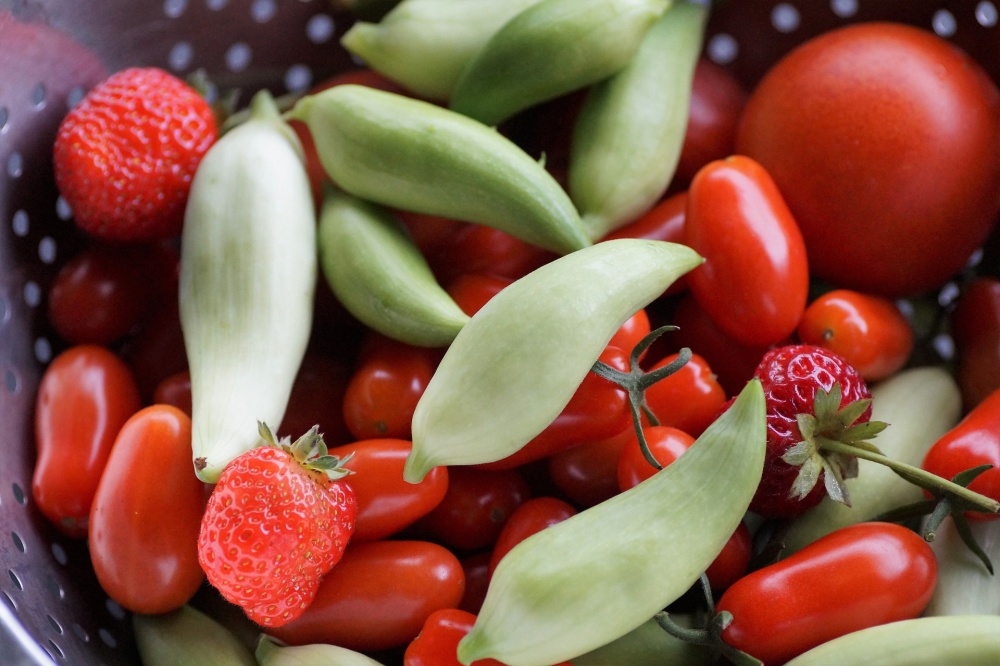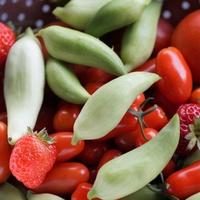Common name: Stuffing cucumber
Other common names: Bolivian cucumber, Ladies slipper, Slipper gourd, Wild cucumber
Description
Stuffing Cucumber or Achocha is an annual vine native to Central and South America, its natural range limited to highland areas extending from Mexico to Peru.
The plant is made up of soft or herbaceous vines that are 3 to 5 m (10 to 16 ft) long, much-branched and with twining tendrils that enable it to climb up, on and over structures.
The leaves are composed of three to five, toothed, light green, lance-shaped leaflets fused at the base, in a cart-wheel shape up to 20 cm (8 in) in diameter. They are attached to the vine on 8 to 10 cm (3 to 4 in) long leaf stalks and give off a strong cucumber aroma when crushed.
The flowers are small, green-white and unisex, the male flowers in small clusters and the female flowers solitary. Flowering occurs from autumn to early winter, in response to shortening daylengths and female flowers that are fertilised develop into chilli-pepper-shaped pods up to 15 cm (6 in ) long. The pods have thin, smooth light green skin and are almost hollow inside, with a small amount of spongy pulp embedded with small black seed.
Use
The small, immature fruit pods without seed are sliced or chopped for adding to salads, while the larger pods are de-seeded stuffed and baked. Traditional recipes call for stuffing the hollow insides with ground meat, seafood, rice, vegetables, or some combination of these before baking them, usually in a tomato-based sauce. They have a subtle flavour similar to an artichoke.

Climate
Grows naturally in sub-humid to moderately humid subtropical and tropical mid- to high-elevation climates, generally areas with annual lows of 11 to 20°C, annual highs of 20 to 29°C and annual rainfall of 500 to 2000 mm.
Growing
New plants are usually started from seed that are sown in the rainy season. It performs best on rich, well-manured, free-draining loam and sand soils of a moderately acid to neutral nature, generally with a pH of 6.0 to 7.0, and on sites with full to partial sun exposure. As the vine grows it needs to be trained to climb on a trellis or similar structure to encourage pollination and fruit development and to make it easier to harvest them.
The pods are harvested when immature, starting around three months after the seed are sown. Pods for salads are ready to be harvested when they are very young and less than 6 cm (2 to 3 in) in length, whereas those destined for the pot or oven are left to grow to around twice that size. Fruiting is reportedly abundant, with a harvesting period lasting months.
Problem features
It is listed as a weed in at least one reference publication but there does not appear to be any record of it anywhere as a serious weed. Assessment of its weed risk for Florida, undertaken by the the University of Florida's Institute of Food and Agricultural Sciences (IFAS) was inconclusive.
Where it grows
References
Books
-
Grubben, G.J.H. & Denton, O.A. (Editors) 2004, Plant Resources of Tropical Africa, Volume 2 : Vegetables, PROTA Foundation, Backhuys Publishers, Leiden
-
Herklots, G. A. C. 1972, Vegetables in south-east Asia, Allen and Unwin, London
-
Janick, J., & Paull, R. E. 2008, The encyclopedia of fruit & nuts, CABI Publishing, Wallingford, Oxfordshire
-
Leon, J & Hernandez Bermejo, J. Esteban & Programma Ethnobotanica 92. 1994, Neglected crops : 1492 from a different perspective, Food and Agriculture Organization of the United Nations, Rome
-
National Research Council (Board on Science and Technology for International Development) 1989, Lost Crops of the Incas: Little-Known Plants of the Andes with Promise for Worldwide Cultivation, The National Academies Press, Washington D. C.
-
Randall, R. P. 2002, A global compendium of weeds, R.G. and F.J. Richardson Press, Melbourne
-
Randall, R. P. 2007, The introduced flora of Australia and its weed status, Cooperative Research Centre for Australian Weed Management, Glen Osmond, South Australia
-
Roecklein, J. C & Leung, P.S. 1987, A Profile of economic plants, Transaction Books, New Brunswick, New Jersey
-
Tindall, H. D 1983, Vegetables in the Tropics, Macmillan Press, London
-
Vavilov, N. I. (Nikolaĭ Ivanovich) & Dorofeev, V. F. (Vladimir Filimonovich) 1992, Origin and geography of cultivated plants, English ed, Cambridge University Press, Cambridge [England] ; New York, NY, USA
-
Winters, H. F & Miskimen, G. W. 1967, Vegetable gardening in the Caribbean area, U.S. Dept of Agriculture, Washington D.C.
Articles, Journals, Reports and Working Papers
-
Vasquez, R. and Gentry, A. H. 1989, Use and misuse of forest-harvested fruits in the Iquitos area. Conservation Biology, 3: 350–361. doi: 10.1111/j.1523-1739.1989.tb00241.x


